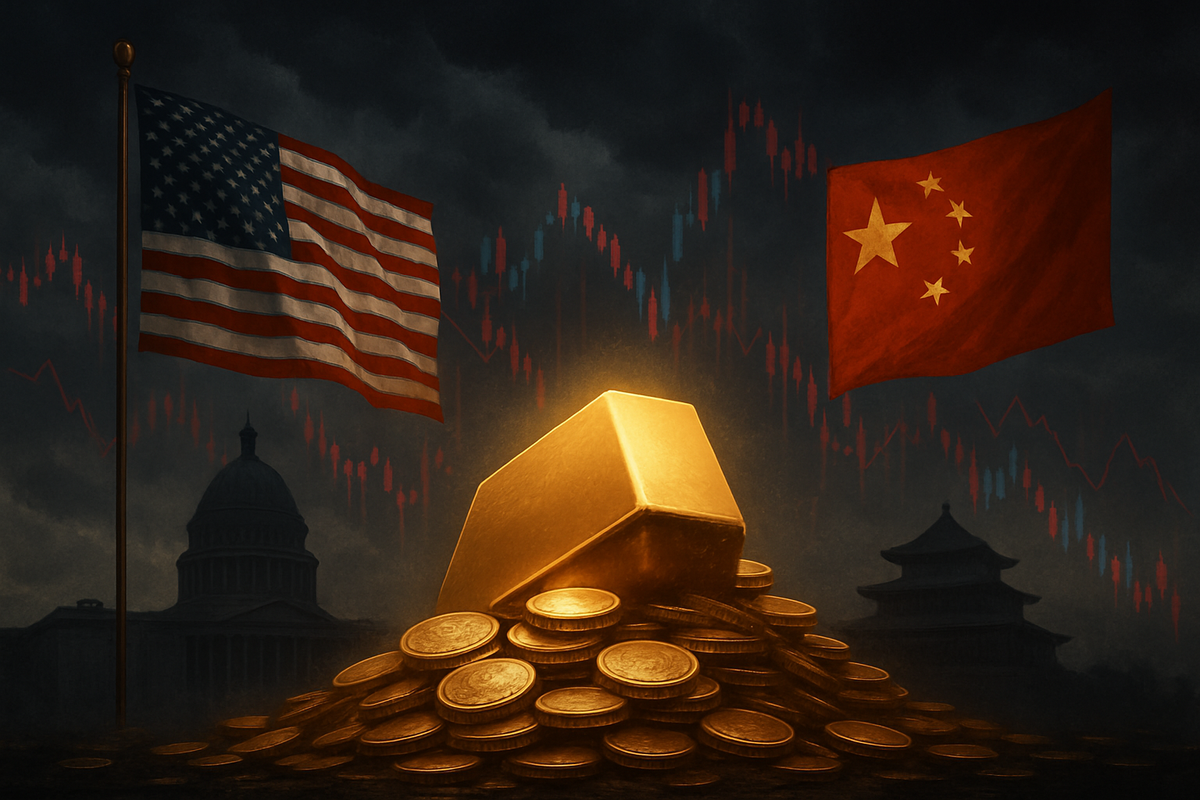
October 16, 2025 – Global financial markets are gripped by a renewed surge in US-China trade tensions, pushing investors into the traditional safe haven of gold. With new tariffs and export controls announced by both economic superpowers, the precious metal's price has soared to unprecedented levels, hovering between $4,240 and $4,280 per ounce, marking a historic rally and reflecting deep-seated anxieties over global economic stability. This dramatic shift underscores a "risk-off" sentiment pervading markets, as the specter of a full-blown economic decoupling between the world's two largest economies becomes increasingly real.
The escalating trade conflict, a persistent undercurrent in global commerce since 2018, has intensified significantly in 2025. The latest round of punitive measures and retaliatory actions has created a volatile environment, leading to widespread uncertainty across industries and geographies. Investors, seeking refuge from potential supply chain disruptions, increased costs, and geopolitical instability, are flocking to gold, driving its value to heights previously unimaginable and solidifying its role as the ultimate store of value in turbulent times.
A Deep Dive into the Renewed Trade Offensive
The current escalation reached a critical juncture in October 2025. On October 10, 2025, the United States, under President Donald Trump, announced a staggering additional 100% tariff on Chinese imports, coupled with stringent export controls on critical software, slated to take effect on November 1, 2025. This aggressive move was a direct response to earlier actions by Beijing.
China, swift in its retaliation, implemented its own export controls on vital rare earth elements—including dysprosium and yttrium—along with related technologies and equipment, superhard materials, and lithium battery components, effective December 1, 2025. These controls mandate licenses for exports containing more than 0.1% rare earths or utilizing Chinese production technology. Furthermore, China added several US defense contractors to its "unreliable entity list" and introduced escalating port fees for US cargo ships, starting at $56 per ton on October 14, 2025, and projected to reach $157 per ton by April 2028. Five US subsidiaries of a Korean shipbuilder were also sanctioned. These actions follow earlier tariff adjustments in April 2025, where US tariffs on Chinese goods reached 104%, and a brief de-escalation in May that saw both nations reduce tariffs, only for those truces to unravel. China's Commerce Minister Wang Wentao, speaking on October 16, 2025, attributed the renewed intensity to "intensive restrictive measures" by the US after September's bilateral talks in Madrid. The highly anticipated meeting between Presidents Trump and Xi Jinping at the APEC summit (October 31-November 1) now hangs in the balance.
As of October 2025, the average US tariffs on Chinese exports stand at 57.6%, encompassing 100% of all goods, while China's average retaliatory tariffs on US exports are 32.6%, also covering 100% of goods. Beyond broad tariffs, the US has imposed a 25% tariff on imported cars and raised tariffs on steel, aluminum, and copper to 50%, with new tariffs also affecting pharmaceuticals and semiconductors. In September 2025, new 10% tariffs on softwood timber and 25% tariffs on certain furniture items were announced, effective October 14, 2025, with further increases slated for 2026.
Initial market reactions have been stark. Global banks have revised down China's economic growth forecasts, and the trade measures are projected to result in a 0.2% loss of global merchandise trade. Major stock indexes in Europe and the US have fallen sharply, reflecting the "risk-off" sentiment. The trade war is also profoundly disrupting global shipping networks, leading to escalating tanker rates, with an estimated 13% of the global crude tanker fleet directly exposed to the new fee structures.
Corporate Fortunes: Winners and Losers in the Crossfire
The escalating trade war creates a clear delineation between potential corporate winners and losers. Companies heavily reliant on complex global supply chains that span the US and China are facing significant headwinds. Manufacturing firms, particularly those in the technology sector (e.g., Apple (NASDAQ: AAPL), Qualcomm (NASDAQ: QCOM)), electric vehicles (e.g., Tesla (NASDAQ: TSLA), Nio (NYSE: NIO)), agriculture, and consumer goods, are grappling with rising input costs, disrupted logistics, and increased uncertainty. For instance, companies that manufacture in China for the US market will face the burden of the new 100% tariffs, potentially forcing them to absorb costs, raise prices, or relocate production – all costly and time-consuming endeavors. US defense contractors, now on China's "unreliable entity list" and subject to sanctions, will see their access to the Chinese market severely curtailed. Global shipping companies, such as Maersk (CPH: MAERSK-B) and Evergreen Marine (TWSE: 2603), are also facing increased operational costs due to China's new port fees and the overall disruption to global trade flows.
Conversely, the surge in gold prices presents a boon for gold mining companies globally. Firms like Barrick Gold (NYSE: GOLD, TSX: ABX), Newmont (NYSE: NEM), and AngloGold Ashanti (NYSE: AU) are likely to see significant increases in their revenue and profitability as the value of their primary commodity skyrockets. Furthermore, companies with diversified supply chains or those focused on domestic production within their respective markets may find themselves relatively insulated from the immediate impacts of the trade war, or even benefit from a push towards regionalization. Industries that can offer alternatives to Chinese-made goods in the US, or vice versa, might also see an uptick in demand. The shift towards safe-haven assets could also indirectly benefit financial institutions specializing in wealth management and precious metals trading, though overall market volatility remains a concern.
Broader Implications and Historical Parallels
This renewed trade offensive is not merely a skirmish; it signifies a profound shift towards a "systemic economic divorce" between the US and China. The aggressive imposition of tariffs and export controls by both nations underscores a broader trend of de-globalization and economic nationalism. This event fits into a wider pattern of countries prioritizing national security and economic self-reliance over unfettered global trade, leading to a fragmentation of global commerce and supply chains. The ripple effects are extensive, impacting not only direct trade partners but also third-party nations and multinational corporations caught in the crossfire.
Regulatory and policy implications are significant. The tit-for-tat actions suggest a future where trade policy is increasingly weaponized as a tool of geopolitical leverage, potentially leading to a more fractured international trading system. This could prompt other nations to re-evaluate their own trade dependencies and potentially seek to diversify their economic partnerships. Historically, gold has always served as a reliable hedge against geopolitical instability and economic uncertainty. Its current rally echoes similar patterns seen during the 2008 Great Recession, when it surpassed $1,900 per ounce in August 2011, and during the COVID-19 pandemic, when it broke above $2,000 per ounce in August 2020. The current situation, however, with gold reaching over $4,200 per ounce, represents an even more extreme flight to safety, indicating a deeper level of systemic risk perceived by investors. The increase of nearly 60% in 2025 alone highlights the unprecedented nature of this rally.
The Path Forward: Scenarios and Strategic Pivots
Looking ahead, the short-term outlook is dominated by uncertainty surrounding the upcoming APEC summit (October 31-November 1). While a meeting between Presidents Trump and Xi Jinping is tentatively scheduled, the recent escalation casts a shadow over the potential for any immediate de-escalation. Investors should brace for continued market volatility as the US tariffs take effect on November 1, 2025, and China's rare earth export controls on December 1, 2025. This period will likely see further disruptions to supply chains and increased costs for businesses and consumers alike.
In the long term, the trade war could accelerate the ongoing restructuring of global supply chains, potentially leading to a more fragmented and regionalized manufacturing landscape. Companies may be forced to strategically pivot, exploring alternative manufacturing hubs outside of China and the US, or investing in domestic production capabilities. This could present opportunities for emerging markets or countries with stable trade relations with both superpowers. Gold prices are likely to remain elevated as long as geopolitical and economic uncertainties persist, with central bank purchases (notably from China and India) providing additional support. Market opportunities may emerge for companies that can adapt quickly to the new trade landscape, offering solutions for supply chain resilience or benefiting from shifts in consumer preferences towards locally sourced goods. Challenges will persist for companies deeply embedded in the US-China trade ecosystem, requiring significant strategic re-evaluation and adaptation.
MarketMinute's Final Assessment
The escalating US-China trade tensions represent a critical inflection point for the global economy. The aggressive imposition of tariffs and export controls by both nations has ignited a profound "risk-off" sentiment, driving gold prices to unprecedented record highs of over $4,200 per ounce. This flight to safety underscores the deep-seated anxieties among investors regarding economic stability and geopolitical fragmentation. The nearly 60% surge in gold's value in 2025 alone highlights the severity of the current situation and the market's perception of systemic risk.
Moving forward, the market will remain highly sensitive to any developments in US-China relations, particularly around the APEC summit. Investors should closely monitor further policy announcements from both governments, the impact of new tariffs on corporate earnings, and the actions of central banks regarding interest rates, which could further influence gold's appeal. The era of seamless global supply chains is rapidly receding, giving way to a more complex and potentially more costly international trade environment. Companies that can demonstrate agility, diversify their operations, and build resilient supply chains will be best positioned to navigate these turbulent waters. The enduring significance of this event lies in its potential to fundamentally reshape global commerce and redefine the parameters of international economic cooperation for decades to come.
This content is intended for informational purposes only and is not financial advice







